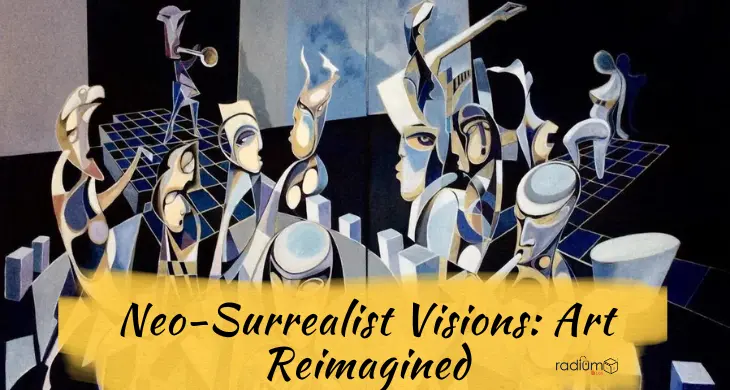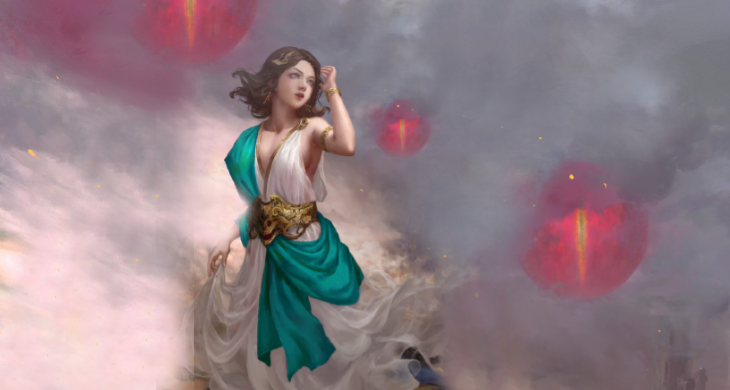Neo-Surrealism, born from the roots of the Surrealist movement of the early 20th century, emerges as an enthralling evolution, embodying the enduring influence of the human subconscious on artistic expression. This captivating art form transcends the boundaries of ordinary reality, ushering viewers into an extraordinary realm where imagination reigns supreme. Nestled within the core of Neo-Surrealism lies a profound exploration of the subconscious mind, intertwining dreamlike visuals, and the crafting of fantastical narratives. Through this genre, audiences embark on an enchanting odyssey, navigating landscapes that defy logic and temporal norms. Neo-Surrealism, a vibrant testament to humanity’s perpetual intrigue with the enigmatic and otherworldly, opens a portal to a universe where imagination knows no confines, liberating art from the shackles of the mundane, and inviting all to revel in the boundless realms of creativity and wonder.
History of Surrealism and Its Evolution:
Surrealism, originating in the early 20th century, emerged as an avant-garde artistic and literary movement primarily centered in Europe. Championed by figures like André Breton, it sought to unlock the power of the subconscious mind through artistic expression. Surrealists aimed to bypass rational thought and tap into the unfiltered depths of the unconscious to produce art that defied logic and reason. Their works often juxtaposed unlikely or illogical elements to create dreamlike, thought-provoking compositions.
This movement was characterized by its embrace of automatic drawing and writing techniques, where artists sought to detach from conscious control, allowing spontaneous and unfiltered expressions to surface. Surrealism flourished through various mediums, including painting, sculpture, literature, film, and even philosophy. For more Art content, be sure to check out the regularly updated RadiumBlog section – Illuminating Your Path to Enlightenment!
Over time, Surrealism evolved, giving rise to Neo-Surrealism, a contemporary extension of the movement. While it retains the core principles of Surrealism, Neo-Surrealism adapts to the modern context, incorporating new techniques, styles, and interpretations. It continues the exploration of the subconscious mind but with a contemporary touch, blending traditional Surrealist elements with innovative approaches and contemporary themes. Neo-Surrealism serves as a bridge between the past and present, embracing the essence of Surrealism while offering a fresh perspective on the enigmatic and the fantastical in art.
Key Artists and Their Works:
Here are a few key artists and some of their prominent works in the realm of Surrealism and Neo-Surrealism:
- Salvador Dalí:
- “The Persistence of Memory”: One of Dalí’s most iconic paintings featuring melting clocks.
- “The Elephants”: An artwork depicting elongated elephants on spindly legs, showcasing Dalí’s surreal imagination.
- René Magritte:
- “The Son of Man”: A famous painting with a bowler-hatted man obscuring his face with an apple.
- “The Treachery of Images”: Known for the caption “Ceci n’est pas une pipe” (This is not a pipe), challenging perception and reality.
- Max Ernst:
- “The Eleventh Hour”: Ernst’s painting depicting strange, otherworldly creatures in a dreamlike landscape.
- “Two Children Are Threatened by a Nightingale”: A haunting and enigmatic piece showcasing Ernst’s fascination with the uncanny.
- Leonora Carrington:
- “The House Opposite”: Surrealist painting capturing Carrington’s dreamlike and mythical narratives.
- “The Pomps of the Subsoil”: A captivating work showcasing Carrington’s exploration of mysticism and transformation.
- Zdzisław Beksiński:
- His dystopian and surrealistic artworks, often depicting haunting and post-apocalyptic scenes, blend elements of surrealism and dark fantasy.
These artists and their works have significantly contributed to the development and evolution of Surrealism and Neo-Surrealism, shaping the movement and inspiring contemporary artists to explore the depths of the subconscious and the fantastical in their creations.
Neo-Surrealism in Contemporary Art:
Neo-Surrealism continues to evolve within contemporary art, blending modern techniques, concepts, and digital mediums with the surrealistic ethos. Here’s a glimpse into its contemporary manifestation:
- Digital Neo-Surrealism:
- Contemporary artists leverage digital tools to create fantastical and dreamlike imagery. They manipulate photographs, incorporate digital painting techniques, and use software to craft otherworldly compositions.
- Abstract Surrealism:
- Artists experiment with abstraction within the surreal realm, using non-representational forms and symbols to evoke subconscious emotions and experiences.
- Conceptual Surrealism:
- Neo-Surrealism today delves deeper into conceptual storytelling, where artworks narrate complex, layered stories through surreal and symbolic imagery.
- Social Commentary:
- Some contemporary Neo-Surrealists use their art to comment on societal issues, blending surrealism with commentary on politics, environment, and human behavior.
- Multidisciplinary Approaches:
- Artists fuse multiple art forms like sculpture, installation, performance, and technology to create immersive, multi-sensory experiences that challenge perceptions.
Neo-Surrealism in contemporary art continues to be a platform for artists to explore the realms of the subconscious, dreams, and the fantastical. It provides a canvas for experimentation and a means to communicate complex ideas through the lens of the surreal.
Themes and Motifs in Neo-Surrealism:
In Neo-Surrealism, artists explore a myriad of themes and motifs that diverge from the conventional and delve into the enigmatic. Here are prevalent themes and motifs:
- Dreamscapes and Fantasies:
- Surreal landscapes, dreamscapes, and fantastical realms dominate Neo-Surrealistic art. These imaginative settings often defy the laws of physics and reality, creating an ethereal and otherworldly atmosphere.
- Metamorphosis and Transformation:
- Symbolic representations of metamorphosis, where figures morph into various shapes or objects, symbolize the evolution and fluidity of the human experience.
- Subconscious Imagery:
- Neo-Surrealists incorporate imagery that hints at the subconscious mind, manifesting through dream symbols, distorted figures, and fragmented realities.
- Symbolism and Allegory:
- Symbolic elements and allegorical references are prevalent, representing deeper philosophical or psychological concepts that challenge the viewer’s perception.
- Nature and Unnatural Elements:
- Contrasts between nature and unnatural elements, juxtaposing organic forms with mechanical or abstract elements, create tension and intrigue.
- Human Psyche and Emotions:
- Exploration of the human psyche, emotions, fears, desires, and anxieties form a central motif, inviting viewers to contemplate the complexities of the human condition.
- Absurdity and Irony:
- Neo-Surrealism often incorporates elements of absurdity and irony, challenging rationality and provoking thought through unconventional juxtapositions.
These themes and motifs intertwine to create a surreal tapestry, inviting viewers into an intriguing and introspective journey through the artist’s interpretation of reality and the imagination.
Critique and Interpretation:
Neo-Surrealism, as an artistic movement, draws upon the foundational principles of Surrealism while incorporating contemporary elements and perspectives. It often explores the subconscious, dreams, and the fantastical, creating thought-provoking, visually stimulating compositions.
In terms of critique, analyzing Neo-Surrealist visions involves several aspects:
- Visual Composition: Evaluate how the artist uses elements like juxtaposition, distortion, and symbolism to create a dreamlike or otherworldly atmosphere. Consider the use of colors, textures, and shapes in conveying emotions or ideas.
- Narrative or Conceptual Depth: Neo-Surrealism often carries narratives or conceptual layers. Examine whether these works present a clear narrative or if they rely more on evoking emotions and impressions. Sometimes, these pieces provoke thought without a distinct storyline.
- Technique and Execution: Assess the technical skill involved, such as the artist’s proficiency in painting, sculpture, digital art, or any medium used. Look for innovation or unique approaches within the traditional Surrealist framework.
- Cultural and Social Commentary: Neo-Surrealism often addresses contemporary issues or societal norms through symbolic imagery. Consider how these artworks reflect or critique the current social, political, or cultural landscape.
Interpretation involves understanding the artist’s intentions and the viewer’s subjective response. Questions to consider might include:
- What emotions or thoughts does the artwork evoke?
- Are there recurring motifs or symbols, and what might they represent?
- How does this piece fit into the larger context of the artist’s body of work or the Neo-Surrealist movement?
- What cultural or historical references can be identified, and how do they contribute to the interpretation?
Ultimately, Neo-Surrealism invites a wide range of interpretations due to its dreamlike, abstract nature. Personal perception and individual experiences greatly influence how one connects with and interprets these visions.
Influence and Legacy:
The influence and legacy of Neo-Surrealist visions encompass several dimensions that have impacted art, culture, and society:
- Artistic Innovation: Neo-Surrealism revitalized the Surrealist movement by infusing it with contemporary ideas, technologies, and cultural influences. Artists explored new techniques, mediums, and concepts, contributing to the evolution of artistic expression.
- Expanded Visual Language: The movement expanded the visual vocabulary by embracing digital art, multimedia installations, and new technologies. This broadening of tools and mediums allowed for greater experimentation and expression within the movement.
- Cultural Impact: Neo-Surrealism challenged traditional perceptions of reality, encouraging viewers to delve into the realms of imagination and the subconscious. This shift influenced other artistic genres and even spilled over into advertising, fashion, and film, impacting popular culture.
- Individual Artists’ Legacies: Prominent Neo-Surrealist artists have left a lasting impact on the art world. Their distinctive styles and contributions continue to inspire new generations of artists, influencing not only visual arts but also literature, film, and music.
- Continued Relevance: The themes explored in Neo-Surrealist visions—such as dreams, subconscious, and the exploration of the mind—remain relevant in contemporary society. The movement’s focus on the inner self, identity, and the human experience continues to resonate with audiences across the globe.
- Global Reach: Neo-Surrealism transcended geographical boundaries, becoming a global movement with artists from various cultural backgrounds contributing their unique perspectives. This diversity enriched the movement and contributed to its lasting impact.
Overall, the legacy of Neo-Surrealist visions lies in its ability to transcend artistic conventions, provoke thought, and challenge perceptions while leaving a rich and enduring imprint on the artistic landscape.
Frequently Asked Questions:
Ques: What defines Neo-Surrealist art?
Neo-Surrealist art is a contemporary extension of the Surrealist movement, focusing on dreamlike, fantastical imagery, often exploring the subconscious, surreal landscapes, and unconventional juxtapositions. It incorporates modern elements, techniques, and cultural influences.
Ques: How does Neo-Surrealism differ from traditional Surrealism?
Neo-Surrealism maintains the core principles of Surrealism but adapts them to the contemporary context. It often incorporates digital media, new technologies, and addresses current societal issues while retaining the dreamlike, subconscious exploration characteristic of Surrealism.
Ques: What are the main themes in Neo-Surrealist art?
Neo-Surrealism frequently explores themes like dreams, the subconscious mind, identity, symbolism, and the intersection of reality and fantasy. It often critiques societal norms or addresses contemporary concerns through symbolic and metaphorical imagery.
Ques: Who are some notable Neo-Surrealist artists?
Some renowned Neo-Surrealist artists include HR Giger, Zdzisław Beksiński, Laurie Lipton, and Mark Ryden, among others. These artists have contributed significantly to the movement and have distinct styles within the Neo-Surrealist genre.
Ques: How does technology influence Neo-Surrealist art?
Technology plays a significant role in Neo-Surrealist art, allowing artists to explore new mediums, such as digital art, computer-generated imagery, and multimedia installations. This integration of technology expands the possibilities for artistic expression and conceptualization.
Conclusion:
Through Neo-Surrealist art, artists delve into the depths of the subconscious, crafting compositions that challenge conventional realities and invite viewers into fantastical realms. The movement’s embrace of new technologies, multimedia, and diverse mediums has expanded the artistic lexicon, fostering innovation and experimentation.
The enduring legacy of Neo-Surrealist Visions lies not only in its visual impact but also in its ability to provoke thought, evoke emotions, and transcend cultural boundaries. Its themes of dreams, identity, societal critique, and the exploration of the human psyche continue to resonate with audiences worldwide.




